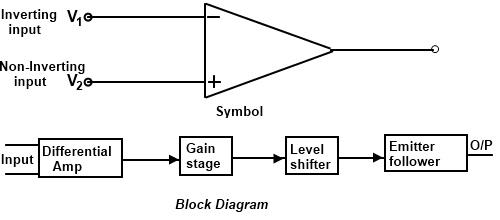Operational Amplifier
The operational amplifier is direct-coupled high gain differential amplifier. The term operational amplifier was originally used for the D.C amplifiers which perform mathematical operation as summation, subtraction, integration and differentiation in analog computers. Besides OP-AMP finds applications in voltage regulators, active filter, instrumentation, analog-to-digital and digital-to-analog converters, and in many other.
OPETATIONAL AMPLIFIER
The operational amplifier or OP-AMP is a direct coupled, high gain amplifier used to perform a wide variety of mathematical operations like summation, subtraction, multiplication, differentiation and integration etc. in analog computers. It is often referred to as the basic linear (or analog) integrated circuit (IC).
The can simplify signals having frequency ranging from 0Hz to about 1MHz.
An ideal operational amplifier has the following characteristics:
- An infinite voltage gain
- An infinite bandwidth
- An infinite input impedance
- Zero output impedance
- Perfect balance i.e., the output is zero when equal voltages are present at the two input terminals.
- The characteristics do not change with temperature.
The symbol and the block diagram of an operational amplifier are shown in Figure.

Differential amplifier
The differential amplifier provides the inverting and non-inverting inputs, the high common mode rejection ration and the high input resistance as well as voltage gain.
Gain Stage
The interior stage of the OP-AMP is required to have a large voltage gain. Often high-β composite transistor such as Darlington pair and common collector emitter cascade are used in the gain stage.
Level Shifter
Since no coupling capacitors can be used (if the OP-AMP is to operate down to D.C), it may be necessary to shift the quiescent voltage of one stage before applying its output to the following stage. Level shifting is also required in order for the output to be close to zero in the quiescent state (no input signal). The input resistance of the level shifting stage should be high to prevent loading of the gains stage. Similarly it is desirable that the output resistance be low to effectively drive the output stage.
Output Stage (Emitter Follower)
The output stage of an OP-AMP must be capable of supplying the external load current and must have a low output resistance. This stage must also provide a large output voltage swing. A common configuration for the output stage that possesses these features is the complimentary emitter follower.
Bias Network
The function of bias network is to provide stable biasing voltage to the active devices in OP-AMP.
OP-AMP PARAMETERS
The main parameters used to describe OP-AMP performance are as follows:
Input Bias Current
The input bias current is the D.C current required by the inputs of the amplifier to property operate the first stage. Inputs are the bases of transistors therefore the input currents are the base current.
Ibias = (I1 + I2) / 2
Input Offset Current
The input offset current (Ios) is the difference of the input bias current expressed as an absolute value
Ios = | I1 – I2 |
Input Offset Current Drift
Input offset current drift is the ratio of the change of input of set current to the change of temperature.
Ios(drift) = ∆Ios/∆T
Here ∆T is the change in temperature.
Input Offset Voltage Drift
The input offset voltage drifts is the ratio of the change of input offset voltage to the change in temperature.
Vos(drift) = ∆Vos/ ∆T
Input Offset Voltage
The input offset voltage is the differential D.C voltage required between the inputs to force the differential output to zero volts. Typical values of input offset voltage are in the range of 2 mV or less. In ideal case it is zero.
Output Offset Voltage Range
This output offset voltage is the difference between the D.C voltage present at the two output terminals (or at the output terminal and ground for an amplifier with one output) when the two input terminals are grounded
Output voltage Range
This is maximum output swing that can be obtained without significant distortion.
Output Impedance
The output impedance (Zout) is the resistance viewed from the output terminals of the OP-AMP.
Input Impedance
The input impedance of an OP-AMP can be specify by two ways that are differential and common mode.
The differential input impedance is the total resistance between the inverting and the non-inverting inputs.
